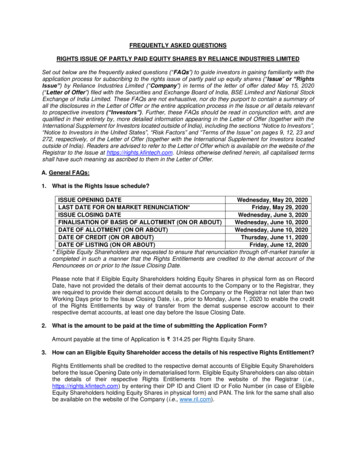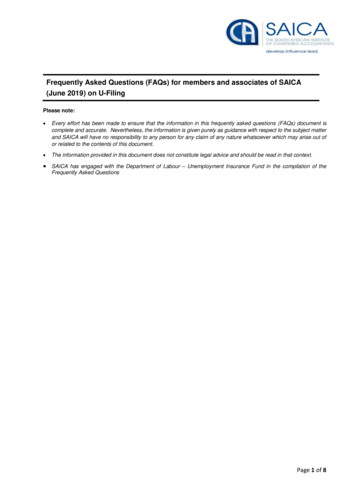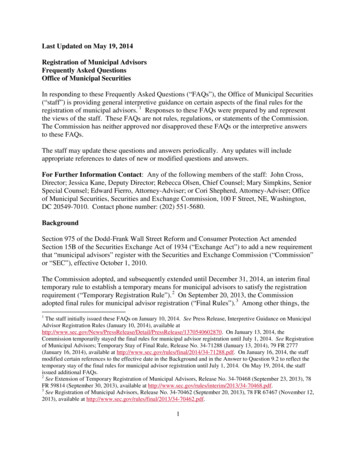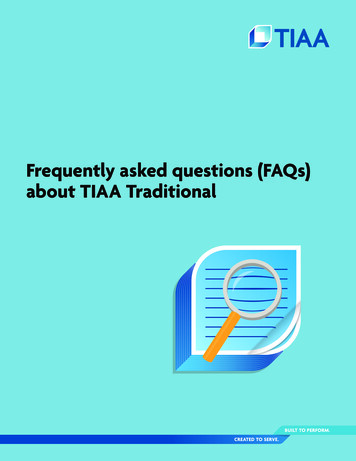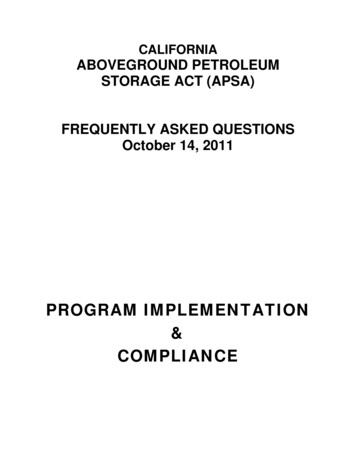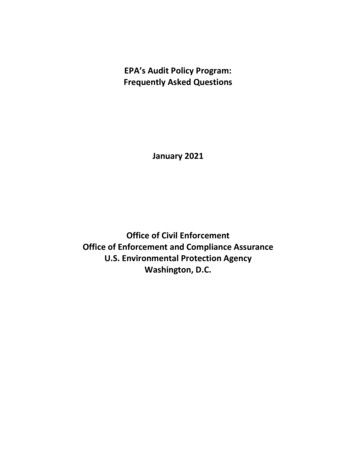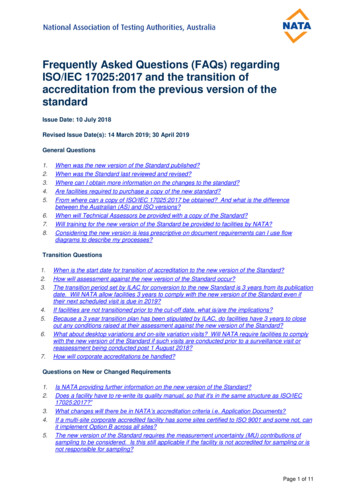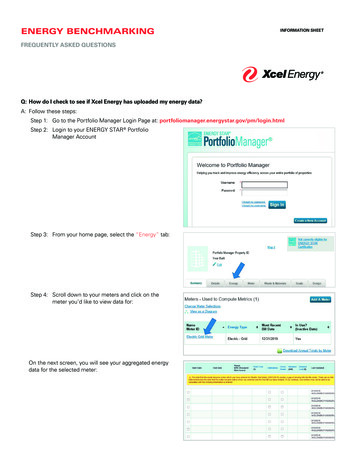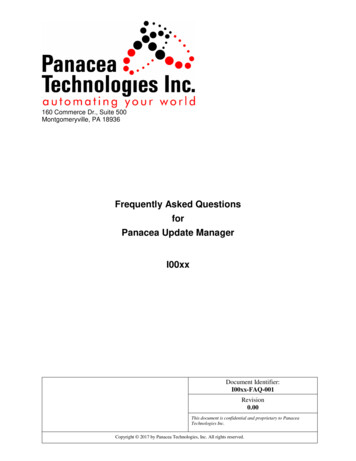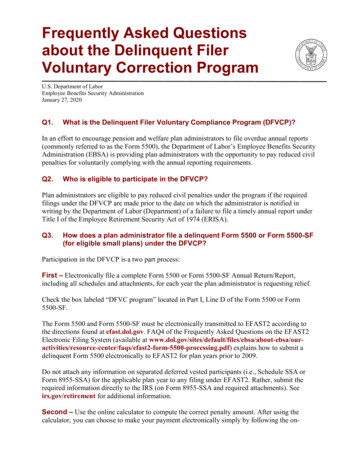
Transcription
Frequently Asked Questionsabout the Delinquent FilerVoluntary Correction ProgramU.S. Department of LaborEmployee Benefits Security AdministrationJanuary 27, 2020Q1.What is the Delinquent Filer Voluntary Compliance Program (DFVCP)?In an effort to encourage pension and welfare plan administrators to file overdue annual reports(commonly referred to as the Form 5500), the Department of Labor’s Employee Benefits SecurityAdministration (EBSA) is providing plan administrators with the opportunity to pay reduced civilpenalties for voluntarily complying with the annual reporting requirements.Q2.Who is eligible to participate in the DFVCP?Plan administrators are eligible to pay reduced civil penalties under the program if the requiredfilings under the DFVCP are made prior to the date on which the administrator is notified inwriting by the Department of Labor (Department) of a failure to file a timely annual report underTitle I of the Employee Retirement Security Act of 1974 (ERISA).Q3.How does a plan administrator file a delinquent Form 5500 or Form 5500-SF(for eligible small plans) under the DFVCP?Participation in the DFVCP is a two part process:First – Electronically file a complete Form 5500 or Form 5500-SF Annual Return/Report,including all schedules and attachments, for each year the plan administrator is requesting relief.Check the box labeled “DFVC program” located in Part I, Line D of the Form 5500 or Form5500-SF.The Form 5500 and Form 5500-SF must be electronically transmitted to EFAST2 according tothe directions found at efast.dol.gov. FAQ4 of the Frequently Asked Questions on the EFAST2Electronic Filing System (available at processing.pdf) explains how to submit adelinquent Form 5500 electronically to EFAST2 for plan years prior to 2009.Do not attach any information on separated deferred vested participants (i.e., Schedule SSA orForm 8955-SSA) for the applicable plan year to any filing under EFAST2. Rather, submit therequired information directly to the IRS (on Form 8955-SSA and required attachments). Seeirs.gov/retirement for additional information.Second – Use the online calculator to compute the correct penalty amount. After using thecalculator, you can choose to make your payment electronically simply by following the on-
2screen instructions when the calculator has computed the penalty amount. You will beautomatically given a receipt for your electronic submission.IMPORTANT: We strongly recommend you electronically submit your payment to the DFVCP.This will help you avoid making costly errors calculating the payments due the DFVCP.You may also make your payment by check by printing out and mailing a paper copy of theelectronically completed and filed Form 5500 or Form 5500-SF, without schedules orattachments, and a penalty check made to the Department of Labor for the applicable penaltyamount (described below).Please note the address change:Effective May 15, 2019, send them to:DFVCPP.O. Box 6200-35Portland, OR 97228-6200We will also begin accepting overnight delivery submissions. Send these to:U.S. BankAttn: DFVC 6200-3517650 NE Sandy Blvd.PD-OR-C1GLPortland, OR 97230There is no address to receive submissions from a private delivery service.Receipts are NOT given for payments by check. When you provide a check as payment, youauthorize us either to use information from your check to make a one-time electronic fund transferfrom your account or to process the payment as a check transaction.IMPORTANT: Even if submitting the penalty check by mail, to avoid costly errors, you shoulduse the online penalty calculator when calculating the payment due to the DFVCP. The calculatoris available at www.askebsa.dol.gov/dfvcepay/calculator.All paper submissions to the DFVCP must be included in the same envelope or package to ensurethat those filings count towards the per-plan capped penalty amount. Similarly, filers submittingto the DFVCP electronically must include information for all filings in the same onlinetransaction in order for the penalty cap to apply.Q4.What is the applicable penalty amount?Small Plan Filers. In the case of a plan with fewer than 100 participants at the beginning of theplan year (hereinafter small plan), the applicable penalty amount is 10 per day for each day theannual report is filed after the date on which the annual report was due (without regard to anyextensions), not to exceed 750. In the case of a DFVCP submission relating to more than one
3delinquent annual report filing for the same plan, the maximum penalty amount is 750 for eachannual report, not to exceed 1,500 per plan.Note: The “80 to 120” participant rule described in 29 § CFR 2520.103-1(d) is applicable indetermining whether a plan is a small or large plan.Example 1. An administrator of a small plan with a calendar year plan year files the annualreport for the 2009 plan year on March 31, 2011. Under DFVCP, the applicable penalty amount is 750 (though the penalty amount calculated at 10 per day would be 2,430 for 243 days, the perfiling cap for small plans of 750 applies).Example 2. Assume the same facts as in Example 1, except that the filer filed annual reports forthe same plan for the 2006, 2007, and 2008 plan years on March 31, 2011. Under the DFVCP, theapplicable penalty amount is 1,500, which is the per-plan filing cap for small plans.Large Plan Filers. In the case of a plan with 100 or more participants at the beginning of theplan year and which is not eligible for the 80/120 participant rule (hereinafter large plan), theapplicable penalty amount is 10 per day for each day the annual report is filed after the date onwhich the annual report was due (without regard to any extensions), not to exceed 2,000. In thecase of a DFVCP submission relating to more than one delinquent filing for the same plan, themaximum penalty amount is 2,000 for each annual report, not to exceed 4,000 per plan.Filers submitting to the DFVCP electronically must include information for all filings in the sameonline transaction in order for the penalty cap to apply. Similarly, all paper submissions to theDFVCP must be included in the same envelope or package to ensure that those filings counttowards the per-plan capped penalty amount.Example 1. An administrator of a large plan with a calendar year plan year files the annualreport for the 2009 plan year on August 6, 2010. The administrator failed to properly extend thefiling due date of July 31, 2010. Under the DFVCP, the applicable penalty amount would be 60(6 days x 10).Example 2. Assume the same facts as in Example 1, except that the filer filed the annual reporton March 31, 2011. Under the DFVCP, the applicable penalty amount is 2,000 (though thepenalty amount calculated at 10 per day would be 2,430 for 243 days, the per-filing cap of 2,000 applies).Example 3. Assume the same facts as in Example 2, except that the filer filed annual reports forthe same plan for the 2006, 2007, and 2008 plan years on March 31, 2011. Under the DFVCP, theapplicable penalty amount is 4,000, which is the per-plan filing cap for large plans.Example 4. Assume the same facts as in Example 3, except that the filer is also submitting anadditional plan year 2006 filing under the DFVCP for another plan. Under the DFVCP, thepenalty amount is 6,000 ( 4,000 applicable to the three filings discussed in Example 3, plus 2,000 for the Form 5500 filed for the other plan).There is now an online DFVCP penalty calculator available to help you easily and accuratelycompute the amount you owe to participate in the program. We encourage you to use thiscalculator so you can avoid any errors that could delay your participation in the program.
4Q5.If not submitting payment electronically, to whom should the check be madepayable?The penalty check should be made payable to the Department of Labor.Q6.Is participation under the DFVCP available to all Form 5500 Series filers?No. The relief under the DFVCP is available only to the extent that a Form 5500 is required to befiled under Title I of ERISA. If annual reporting for a plan is only required under the InternalRevenue Code, it is not eligible for penalty relief under DFVCP. However, IRS penalties may stillapply. For example, plans covering only self-employed individuals, sole owners (and theirspouses) or partners (and their spouses) are not subject to Title I of ERISA. Such plans electing tofile Form 5500-SF with EFAST2 instead of filing the Form 5500-EZ with the IRS are not eligibleto participate in the DFVCP program. Plan administrators may call 202-693-8360 if they havequestions about whether the program applies to their filings.Q7.Which version of the Form 5500 should be filed?Generally, the filer should file using the correct year form that is delinquent. However, there areexceptions. The Department has available on its website at www.dol.gov/agencies/ebsa an onlinetool to help delinquent filers determine which versions of Forms 5500/5500-SF and schedules touse. Filers simply enter very limited information as prompted (such as the beginning date of theplan year for which the late filings are made) and the tool identifies the correct versions of theForms 5500/5500-SF to use. FAQ 4 of the Frequently Asked Questions on the EFAST2Electronic Filing System (available at processing.pdf) explains how to submit adelinquent Form 5500 electronically to EFAST2 for plan years prior to 2009.CAUTION: Do not include a Schedule SSA or IRS Form 8955-SSA (information on separated,deferred vested participants) in an electronic filing with EFAST2. Rather, submit the Form 8955SSA to the IRS (along with all required attachments). See irs.gov/retirement for additionalinformation.Q8.What civil penalties may be assessed by the Department against planadministrators who fail to file a timely annual report and who do notparticipate in the DFVCP?The following penalties may be assessed against plan administrators:Late Filers - Plan administrators filing a late annual report (i.e., after the date the report wasrequired to be filed, including extensions) may be assessed 50 per day, with no limit, for theperiod they failed to file, determined without regard to any extensions for filing.Non-Filers - Plan administrators who fail to file an annual report may be assessed a penalty of 300 per day, up to 30,000 per year, until a complete annual report is filed.
5Q9.A plan administrator for a plan is delinquent on annual report filings formultiple years. If during that period, the plan’s classification has shiftedbetween being a large and small plan, which penalty cap applies to theplan’s DFVCP submission?If, during the years of non-filing, there is at least one year where the plan is a large plan, forpurposes of the DFVCP the plan must use the large plan penalty amounts of 10 per day up to amaximum of 2,000 per filing, not to exceed 4,000 per plan.Q10. Is there a different per-plan penalty cap that applies to administrators ofsmall plans sponsored by Internal Revenue Code (Code) section 501(c)(3)organizations (including Code section 403(b) small plans)?Yes. In the case of a small plan sponsored by a Code section 501(c)(3) organization (including aCode section 403(b) small plan required to file an annual report), the applicable penalty amount is 10 per day for each day the annual report is filed after the date on which the annual report wasdue (without regard to any extensions), not to exceed 750 regardless of the number of delinquentannual reports for the plan submitted as part of the same DFVCP submission.This per-plan penalty cap, however, will not be available if, as of the date the plan files under theDFVCP, there is a delinquent or late annual report due for a plan year during which the plan wasa large plan, in which case the large plan cap will apply.If you are using the online penalty calculator or choose to submit to the program electronically,you must answer “Yes” on the calculator to the question “Are you a 501(c)(3) organization?” Ifyou are paying by mail you must include the notation “501(c)(3) Organization” in the upper-rightcorner of the first page of the paper print out of the electronically filed Form 5500 or Form 5500SF that must be mailed to the DFVCP, along with the penalty check.Q11. Are extensions considered when calculating penalties under the DFVCP?No. All penalties under the DFVCP are calculated at 10 per day, beginning on the day after thedate the filing was due, without regard to any extensions.Q12. May plans participate in the DFVCP if they have already receivedcorrespondence from the Department or the IRS?Plan administrators are eligible to pay reduced civil penalties under the program if the requiredfilings under the DFVCP are made prior to the date on which the administrator is notified inwriting by the Department of a failure to file a timely annual report under Title I of ERISA.An IRS late-filer letter will not disqualify a plan from participating in the DFVCP.A Department of Labor Notice of Intent to Assess a Penalty will always disqualify a plan.Q13. Does a plan administrator waive any rights upon filing under the DFVCP?Yes. Payment of the penalty amount under the terms of the DFVCP constitutes, with regard to thefilings submitted under the Program, a waiver of the right both to receive notice of the penalty
6assessment from the Department and to contest the Department’s assessment of the DFVCPpenalty amount.Q14. If a filing has been made under the DFVCP, will the plan administrator beliable for any other Department of Labor annual reporting civil penalties?Annual reports that are filed under the DFVCP are subject to the usual edit checks and otherenforcement reviews. Plan administrators generally will have an opportunity to correctdeficiencies in accordance with the procedures described in 29 CFR § 2560.502c-2. The failure tocorrect deficiencies in accordance with these procedures may result in the assessment of furtherdeficient filer penalties.Q15. Can plan assets be used to pay the civil penalties assessed under ERISA §502(c)(2)?No. The plan administrator is personally liable for the payment of civil penalties assessed underERISA § 502(c)(2). Civil penalties, including penalties paid under the DFVCP, cannot be paidfrom the assets of an employee benefit plan.Q16. May an administrator of an apprenticeship and training plan, as described in29 CFR § 2520.104-22, or an administrator of a top hat plan, as described in29 CFR § 2520.104-23, participate in the DFVCP?Yes. Administrators of apprenticeship and training plans and administrators of pension plans for aselect group of management or highly compensated employees (top hat plans), may file theapplicable notice and statement described in regulation §§ 2520.104-22 and 2520.104-23,respectively, under the DFVCP in lieu of filing any past due annual reports. By properly filingthese statements as described in regulation §§ 2520.104-22 and 2520.104-23 and meeting theother applicable DFVCP requirements, administrators will be considered as having electedcompliance with the exemption and/or alternative method of compliance prescribed in §§2520.104-22, or 2520.104-23, as appropriate, for all subsequent plan years.Q17. How does an administrator of an Apprenticeship & Training Plan participatein the DFVCP?The plan administrator must file their Apprenticeship and Training Plan Notice described inregulation section 29 CFR § 2520.104-22 electronically on the Department of Labor’s website lan-filing-instructions.The plan administrator must also submit to the DFVCP, either electronically or on paper throughmail or using a private delivery service.If submitting to the DFVCP electronically, follow the calculator instructions for online paymentat efast.dol.gov. Use plan number 999 for all apprenticeship and training plans. You will be givena receipt for your electronic submission.If sending your DFVCP submission to the Program using paper and making payment by check,the plan administrator must complete the most current Form 5500 Annual Return/Report (without
7schedules or attachments), items 1a–1b, 2a–2c, 3a–3c, and use plan number 999 for allapprenticeship and training plans. The paper copy of the form must be signed and dated, and beaccompanied by a check for 750 made payable to the U.S. Department of Labor, and mailed to:Please note the address change:Effective May 15, 2019, send them to:DFVCPP.O. Box 6200-35Portland, OR 97228-6200We will also begin accepting overnight delivery submissions. Send these to:U.S. BankAttn: DFVC 6200-3517650 NE Sandy Blvd.PD-OR-C1GLPortland, OR 97230There is no address to receive submissions from a private delivery service.Receipts are NOT given for payments by check. When you provide a check as payment, youauthorize us either to use information from your check to make a one-time electronic fund transferfrom your account or to process the payment as a check transaction.Note: A paper submission of the Form 5500 to the DFVC program is in addition to thesubmission of the statement described in regulation section 29 CFR § 2520.104-22 that is fileddirectly with the Department. Additionally, the Form 5500 prepared for DFVCP purposes shouldnot be filed with EFAST2.The applicable 750 penalty cap is for each DFVCP submission, without regard to the number ofplans maintained by the same plan sponsor for which the notices and statements are being filed orthe number of participants covered by the plan or plans.
8Q18. How does an administrator of a Top-Hat Plan participate in the DFVCP?The plan administrator must file their Top Hat Plan statement described in regulation section 29CFR § 2520.104-23 electronically on the Department of Labor’s website ns.Note: If a plan sponsor has more than one top hat plan that is participating in the DVFCPat the same time, a single statement covering all of the plans may be filed consistent with thegeneral requirements for top hat plan filings under 29 CFR § 2520.104-23.The plan administrator must also submit to the DFVCP, either electronically or on paper throughthe mail or by using a private delivery service.If submitting to the DFVCP electronically, follow the calculator instructions for online paymentat efast.dol.gov. Use the plan number 888 for all top hat plans. You will be given a receipt foryour electronic submission.If sending your DFVCP submission to the Program using paper and making payment by check,complete the most current Form 5500 Annual Return/Report (without schedules or attachments),items 1a–1b, 2a–2c, 3a–3c, and use plan number 888 for all the top hat plans covered by the tophat plan filing under 29 CFR § 2520.104-23. The paper copy of the form must be signed anddated, and be accompanied by a check for 750 made payable to the U.S. Department of Labor,and mailed to:Please note the address change:Effective May 15, 2019, send them to:DFVCPP.O. Box 6200-35Portland, OR 97228-6200We will also begin accepting overnight delivery submissions. Send these to:U.S. BankAttn: DFVC 6200-3517650 NE Sandy Blvd.PD-OR-C1GLPortland, OR 97230There is no address to receive submissions from a private delivery service.Receipts are NOT given for payments by check. When you provide a check as payment, youauthorize us either to use information from your check to make a one-time electronic fund transferfrom your account or to process the payment as a check transaction.Note: A paper submission of the Form 5500 to the DFVC program is in addition to thesubmission of the statement described in regulation section 29 CFR § 2520.104-22 that is filed
9directly with the Department. Additionally, the Form 5500 prepared for DFVCP purposes shouldnot be filed with EFAST2.The applicable 750 penalty cap is for each DFVCP submission, without regard to the number ofplans maintained by the same plan sponsor for which the notices and statements are being filed orthe number of participants covered by the plan or plans.Q19. Is the DFVCP applicable to filings made by direct filing entities (DFEs) (i.e.,master trust investment accounts, pooled separate accounts,common/collective trusts, 103-12 IEs, and group insurance arrangements)?The DFVCP is not applicable to DFE filings made for master trust investment accounts, pooledseparate accounts, common/collective trusts and 103-12 IEs. The Form 5500 filed by these DFEsis an integral part of the annual report of the participating employee benefit plans. If a Form 5500was timely filed for the participating employee benefit plans, a failure to timely file a DFE Form5500 for these entities may cause the plan’s annual report to be incomplete or inaccurate, but itdoes not result in the plan being a late or non-filer. The plan’s Form 5500, however, may besubject to rejection for being incomplete or inaccurate, and, if rejected, a plan administrator whofailed to correct the problem would be subject to penalty assessments by the Department.A Form 5500 filed for a group insurance arrangement (GIA) under the Department’s regulationsrelieves the plan administrators of the individual plans participating in the GIA from therequirement to file a separate Form 5500/Form 5500-SF for each plan. The Department will allowa GIA that failed to file a GIA Form 5500 on time to use the DFVCP to correct the late filing.GIAs participating in the DFVCP are subject to the conditions applicable to large plan filers.Q20. Is it possible to obtain a waiver from the applicable Department penaltyamount under the DFVCP if the plan administrator can demonstrate thatthere is reasonable cause why the penalty should not be assessed?No. Payment of a penalty under the terms of the DFVCP constitutes a waiver of anadministrator’s right both to receive a notice of assessment from the Department and to contestthe Department’s assessment of the penalty amount. If the plan administrator chooses not towaive these rights, the plan administrator must file the delinquent annual report in the regularmanner and not pursuant to the DFVCP; the administrator can then contest the Department’sassessment of the normal late penalty amount.Q21. Does participation in the DFVCP protect the plan administrator from otherpenalties that may be assessed by the Internal Revenue Service (IRS) or thePension Benefit Guaranty Corporation (PBGC) for failing to timely file aForm 5500 Annual Return/Report?The Department understands that the IRS may provide relief from filing penalties under theInternal Revenue Code for a delinquent Form 5500 or Form 5500-SF for a Title I plan if (i) allapplicable conditions of the DFVC Program have been satisfied, and (ii) any information requiredconcerning separated deferred vested participants (Form 8955-SSA) for the applicable plan yearhas been filed directly with the IRS.The Department understands the PBGC has agreed to provide certain penalty relief under theCode and Title IV of ERISA for delinquent Form 5500s filed for Title I plans where the
10conditions of the DFVCP have been satisfied. Check with the IRS and PBGC for furtherinformation on penalty relief under the Code and Title IV of ERISA.Q22. How can a plan administrator obtain Form 5500 and Form 5500-SF formsand related schedules and instructions?To obtain correct-year schedules and related instructions, go to efast.dol.gov and print theschedules and instructions of the form year that corresponds to the plan year for which you arefiling. FAQ4 of the Frequently Asked Questions on the EFAST2 Electronic Filing System(available at processing.pdf) explains how to submit a delinquent Form 5500electronically to EFAST2 for plan years prior to 2009 or otherwise outside of the EFAST2 currentprocessing cycle.Q23. Where can a plan administrator obtain more information about the DFVCP?For more information about the DFVCP, call EBSA’s Office of the Chief Accountant at 202-6938360 or visit our web site at efast.dol.gov.
Do not attach any information on separated deferred vested participants (i.e., Schedule SSA or Form 8955-SSA) for the applicable plan year to any filing under EFAST2. Rather, submit the required information directly to the IRS (on Form 8955-SSA and required attachments). See irs.gov/retirement for additional information. Second -


